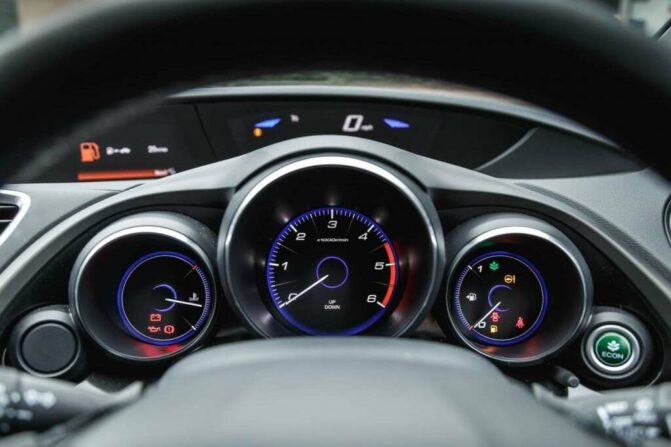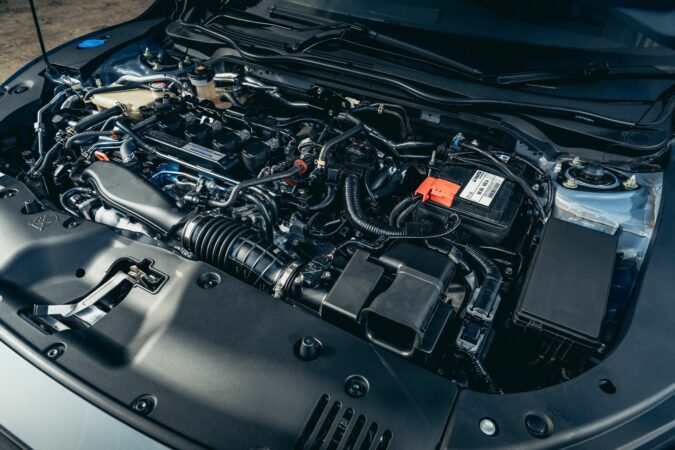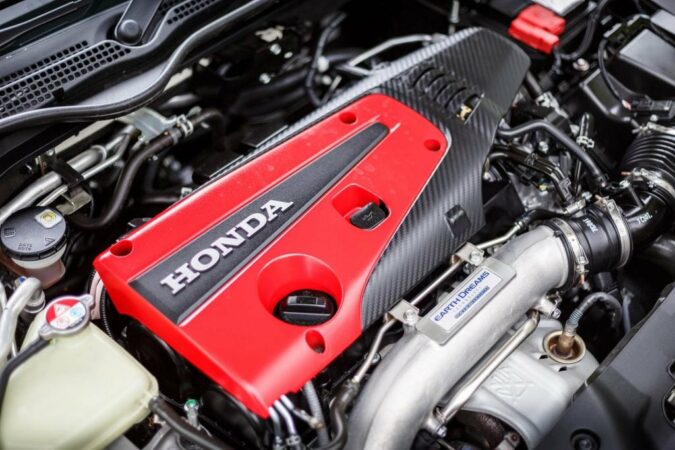Honda is a manufacturer renowned for producing some of the most reliable cars on the road today. But, that is not to say that these vehicles aren’t without any issues. However, there is one code popular among many Honda owners. Can you guess what it is? If you guessed A13, you’re correct! So, what does the Honda A13 service mean?
Performing vehicle maintenance work at the scheduled intervals is essential for preserving its longevity. But, most drivers skip this work with the hopes of saving a few dollars. However, this can come back to haunt you in the future, as skipped maintenance work is one of the leading causes of reliability issues.
In this article, we’ll tell you all about several services that should be conducted on Honda vehicles. We will also give information on the work performed during these services, as well as the consequences of not performing them as recommended by the manufacturer.
Honda Maintenance
Before talking about the Honda A13 service, we thought of giving you an introduction to Honda maintenance as a whole. Japanese vehicles are loved by many gearheads for their reliability, and Honda is a brand that ranks at the top of the table in this aspect.
But, it is important to add that some of their most popular models such as the Accord, Civic, Fit, Element, and Pilot have some known maintenance issues.
1. Honda Accord Maintenance Issues
The Honda Accord is one of the best-selling family sedans in the world, and it is easy to see why. This vehicle is one of the most bang-for-buck deals you can have on the current market.
It offers a mix of practicality and reliability, wrapped up in a stylish and technologically advanced exterior. For decades, the Accord has been a go-to vehicle for people looking for a reliable yet comfortable daily driver.
Some of the most common reliability issues that have plagued Honda Accord models throughout the years include transmission slipping, faulty door locks as well as premature brake rotor wear.
Electrical issues are another common complaint of Honda Accord owners. Underpowered dash lights, failure of the stereo backlight, and underpowered batteries are some electrical gremlins present in this model.
In addition, the Honda Accord suffers from a few engine issues too. The ignition switches are known to fail prematurely, and the V6-powered Accords have a reputation for excessive oil consumption. Uncomfortable seats and headrests are other problems with the Accord. However, this problem is mostly specific to the ones made in 2017.
If you’re curious, we’ve compiled a list of Honda Accord model years to avoid, as well as the best Honda Accord model year. Elsewhere, we discussed common Honda Accord problems, such as Honda Accord transmission problems, and the ‘check fuel cap’ error on the Honda Accord.
2. Honda Civic Maintenance Issues
The Civic is another best-selling model from Honda, which is loved by many people around the world. Nonetheless, it too suffers from some widespread maintenance issues. It shares some of these problems with the Accord, including the brake rotor and transmission issues.
One of the most severe maintenance problems to affect the Civic was the Takata airbags saga, where the airbags fitted to some models had the risk of violently exploding in case of an accident. In addition, the 2006 model of the Civic is well known to develop coolant leaks due to cracks in the engine blocks.
It is important to note that not all Honda Civic maintenance issues are that serious. One such minor problem was errors related to the emissions systems and electronic parking brake being displayed due to a buggy software update.
Issues with Bluetooth connectivity, peeling exterior paint, cracked sun visors, and leaking AC compressors are a few other widely reported Honda Civic maintenance issues. Knowing these issues is important for you to understand just how long do Honda Civics last.
Other than that, we’ve previously looked at the Civic before, such as discussing the electric parking brake problem on the Honda Civic. Additionally, you could also learn more about the Honda Civic air conditioner recall, issues where your Honda Civic won’t start, and the 2017 Honda Civic oil type.
3. Honda Fit Maintenance Issues
Compared to the other models we discussed earlier, the Honda Fit suffers from a relatively fewer number of maintenance issues. Therefore, it’s a good idea to research which is the best year for Honda Fit. But, that is not to say that everything is all sunshine and rainbows.
There are a few common maintenance issues with the Fit, such as starter motor failure, ignition coil issues, power steering problems, as well as engine failure. Apart from mechanical issues, there are some cosmetic problems with the Honda Fit as well.
These include cracked armrests, peeling & cracking of the paint, and wearing of the clear coat. Akin to the 2017 Accord, uncomfortable seats are a common complaint from Honda Fit owners of vehicles made during 2015.
4. Honda Element Maintenance Issues
The Element was a fun and quirky SUV by Honda, and it has developed a cult following since it went out of production. Some reliability problems with this vehicle have surfaced in the following years, such as faults in the rear tailgate, breakdown of the differential fluid, and defective clear coat.
The 2003 Honda Element had a unique issue where the keys couldn’t be inserted into the ignition, thus requiring repairs. Engine oil leaks also made an appearance during this year, and persisted all the way to 2011.
The culprit behind this problem was the defective engine oil pressure sensor. Erratic SRS warning signals due to faults in the seat belt wiring harness were another maintenance issue present with the Element. So, be wary of the Honda Element model years to avoid.
5. Honda Pilot Maintenance Issues
The final Honda we’ll be taking a look at today is the popular Pilot SUV. The 2016 version of this model suffers from several maintenance issues like clogging of the fuel injectors, and EGR valve failure.
Other common problems with the Pilot include the likes of electrical issues, excessive oil consumption, transmission problems, and excessively worn brake rotors. Honda Pilots made between the years 2003 – 2013 had an issue where overheating of the wiring harness caused the low beams to become defective.
As a result, drivers had to be extra vigilant when navigating at night. Oftentimes, performing maintenance work during the manufacturer-recommended intervals is the best way of avoiding these problems.
Luckily for Honda owners, most modern vehicles from the Japanese manufacturer come with a system called “Maintenance Minder” to help you with this task. Understanding how this system works is essential if you want to get the most out of your Honda.
Are you curious about the Honda Maintenance Minder? If so, don’t worry. We have got you covered! Follow us along to the next chapter to find out everything there is to know about the Honda Maintenance Minder.
But before that, do check out our guide on the best model year of the Honda Pilot, as well as the Honda Pilot model years to avoid. We’ve also looked into whether is a Honda Pilot a good car, in addition to servicing items such as the timing belt replacement cost for a Honda Pilot.
Elsewhere, we’ve even discussed common issues with the Honda Pilot, such as the Honda Pilot transmission problems, and other common Honda Pilot problems, like how your Honda Pilot won’t start.
Honda Maintenance Codes
Using the information obtained from the engine, the Honda Maintenance Minder system calculates and displays the remaining lifespan of your engine oil. This percentage starts at 100% when the engine oil is brand new, and it will worsen as time passes and the oil deteriorates.
This eliminates the need for Honda owners to remember their service schedules from memory. Knowing about the Maintenance Minder won’t be useful if you don’t know how to decipher its messages.
Luckily for you, these codes are written in a way that is easy to understand for even the most casual owners. The Honda Maintenance Minder codes can be categorized into three main parts – messages, main items (symbols), and sub-items (numbers).
We’ve previously discussed other similar Honda maintenance minder codes before. That includes the Honda B16 service, B13 Service Honda Civic, and the Honda A12 Service codes.
Honda Maintenance Codes #1 – Messages
Messages are the easiest Honda maintenance code type to understand. They are written in plain words and don’t need any deciphering.
When your vehicle is due for service soon, you’ll probably come across the “Oil Life 15%” message. Once you spot it, you might want to consider scheduling an appointment at your local Honda dealer and taking your vehicle in for service.
Similarly, the “Oil Life 5%” means that you should take your vehicle for maintenance as soon as possible. If the message displayed is “Oil Life 0%”, your vehicle is at serious risk of harmful wear. Ideally, you should always take precautions to avoid this situation from arising.
Honda Maintenance Codes #2 – Symbols
There are two common maintenance main items or symbols in the Honda Maintenance Minder system. If your vehicle displays the letter “A”, it is an indication to replace the engine oil. On the other hand, “B” signifies a severe situation.
If the Maintenance Minder is showing “B”, you should first change the engine oil along with the oil filter. Furthermore, you should clean and lubricate both the front and rear brakes. Not only that, but you should adjust the parking brake, and give a thorough once-over to the entire braking system.
Honda Maintenance Codes #3 – Numbers
The Honda Maintenance Minder uses a series of 8 numbers to convey different messages. 0 indicates that you need to perform a multi-point inspection of your vehicle. 1 means that the tires need to be rotated, while 2 is an indication to replace the air filters, and the pollen filter as well as to inspect the drive belt.
In the same way, if the Maintenance Minder shows number 3, you should replace the transmission fluid of your vehicle along with the transfer fluid if your vehicle is equipped with such a system.
If the indicated number is 4, the spark plugs, timing belt, water pump (to learn more, check out our guide on what does a water pump do for your car), and valve clearance should be inspected and replaced if they are faulty.
5 indicates that the engine coolant should be replaced, and 6 shows that the rear differential fluid needs a change. Finally, if the Honda Maintenance Minder system is indicating number 7 as the service subcode, you should replace the brake fluid.
Apart from being easy to understand, the Honda Maintenance Minder has several other benefits such as,
- Improve The Resale Value
- Extending The Vehicle’s Lifespan
- Preventing The Wastage Of Natural Resources
- Increasing Reliability
So, the next time you go for a drive in your Honda, make sure that you keep an eye on the Maintenance Minder system.
Honda A13 Service
Now, let’s shift our attention toward our main subject today, which is the Honda A13 service. With all the knowledge that you now possess about the Honda Maintenance Minder system, it should be fairly easy for you to decode this code and understand what it means. Go ahead, give it a try.
Having trouble decoding the Honda A13 service message yourself? Well, in that case, let us give you a hand.
- A – Oil Change
- 1 – Tire Rotation
- 3 – Transmission Fluid Replacement
But, why are these maintenance activities so important? In order to understand that, we should take a deeper dive.
Performing regular oil changes is one of the best ways to ensure the longevity of your engine. You see, motor oil is responsible for several activities inside the engine, and as it ages, it loses some of its functionality. So, performing the oil changes when the Honda Maintenance Minder informs you to do so is essential for the well-being of your vehicle.
Honda A13 Service #1 – Oil Change
As we already mentioned, engine oil is responsible for several key activities within the engine. Changing it at the scheduled intervals hands you many benefits. Protecting the engine against corrosion is one such advantage.
You see, your engine is highly vulnerable to corrosion from natural elements like water, dust, dirt, and corrosive air particles.
New engine oil acts as a layer of protective coating, that prevents these elements from corroding the internals of your engine.
Preventing the wear and tear of your engine is another benefit provided by frequent engine oil changes. As an engine runs, its internals creates a lot of friction. Lubricants like engine oil reduce this friction, limiting wear and tear.
Similarly, engine oil keeps the internals clean of debris such as metal shavings in the oil. Without the protection of motor oil, this debris can wreak havoc on the internals, causing damages that would take thousands of dollars to repair.
In addition to the above benefits, improving fuel efficiency, reducing repair costs, and cooling the engine’s internals are some other advantages provided by an engine oil change. So, make sure that your engine is filled with new engine oil whenever you perform the Honda A13 service.
If you want to learn more, head over to our guides on what happens if you don’t change your oil, how many miles can you go over an oil change, is it cheaper to change your own oil, and how much does an oil change cost to find out what an oil change typically entails.
Honda A13 Service #2 – Tire Rotation
The “1” in the Honda A13 service code is an indication for you to rotate the tires. Ideally, a good rule of thumb is to rotate the tires every 5000 miles. This ensures that there is even tread wear on all four tires.
There are many benefits of performing tire rotations. The first and most obvious one is ensuring even tire wear. Although you might not believe it, different tires on your vehicle perform functions differently from one another. As a result, they wear out unevenly, which can have an effect on overall vehicle performance.
This is what causes tire wear on the inside, in addition to the outside of the front tires wearing. The former is also what’s called inside tire wear, or otherwise as inner tire wear.
Performing tire rotations prevents tire tread cupping as well. Tread cupping reduces the traction on the wheels, making the vehicle bounce when driving down the road. In addition, it results in increased noises and vibrations as well.
Tire rotations are a great way of extending their lifespan, and saving you some money as well. So, make sure that you perform them when your vehicle instructs you to do so. Just be wary of the tire rotation cost before you get one scheduled in, though.
Honda A13 Service #3 – Transmission Fluid Replacement
Replacing the transmission fluid is another part of the Honda A13 service. Changing the transmission fluid also has a number of advantages. As this fluid ages, it gets contaminated with dirt and debris.
As a result, the effectiveness of the fluid reduces, thus increasing the chance of transmission failure. Reducing the risk of transmission problems is one of the main advantages of replacing this fluid during the A13 service. Furthermore, replacing the transmission fluid improves the fuel economy of vehicles as well.
For more insight, check out our guide on whether should you change transmission fluid. When your engine and transmission run smoothly, your vehicle becomes more fuel efficient. Moreover, transmission fluid changes improve ride comfort by making gear shifts more seamless.
Overall, performing the Honda A13 service on time can reap many benefits, and save you a significant amount of money that would otherwise be spent on repairs down the line. If you want to learn more, you can get more insight by checking out our guide on the transmission fluid change cost for your Honda and how often do you change transmission fluid.
Elsewhere, we’ve discussed the cost of a transmission fluid change in general, as well as whether you need to check the transmission fluid while it’s hot or cold. We’ve also looked into how to check the transmission fluid, the symptoms of low transmission fluid, and what happens if you have too much transmission fluid in your car.
Honda B1 Service
Similar to the A1 service, the Honda B1 service reminds you to do the following work on your Honda vehicle.
- Replace Engine Oil
- Change Oil Filter
- Perform A Brake Inspection
- Parking Brake Adjustment
- Inspect Fuel Lines And Other Connections
Under ideal conditions, you should perform the Honda B1 service every 5000 to 7500 miles. This translates to performing this work once every 6 months. Ignoring the B1 service puts your vehicle at serious risk of damage, so make sure that you get this work done as scheduled.
Oil Life 15
Displaying the current oil life of your vehicle is another important feature of the Honda Maintenance Minder system. It can be used as an indication to determine how long you have until an oil change needs to be performed.
When the oil life of your Honda reaches 15%, a yellow wrench icon (almost similar to the wrench light on a Ford Fusion) will be displayed on the dashboard. However, this is not to say that driving your vehicle past this point is dangerous.
Nonetheless, we recommend you get the oil replaced as soon as possible by a certified mechanic. If you are handy with a few hand tools, you can even perform an oil change in the comfort of your home.
Honda A12 Service
The Honda A12 service is another common maintenance code that will be displayed when your vehicle determines that it needs an oil change, a tire rotation, or an engine air filter change. While you take care of the recommended items, keep an eye on other important factors like the oil life as well.
Wrench Light Honda
If the symbol of a wrench light has been illuminated on your Honda’s dashboard, your next maintenance appointment is due soon. This light is a component of the Honda Maintenance Minder system, which is designed to make keeping track of vehicle maintenance easy for the owners.
Honda Maintenance Minder Reset
If you get the repairs recommended by the Maintenance Minder at a Honda dealership, there won’t be any need to reset the system. However, if you perform the work yourself, you have to reset it in order to let the vehicle know the repairs have been done.
Resetting the Maintenance Minder is a process that involves several steps. First, press the start/stop button twice to turn on the electrical system. Then, navigate to the oil life display using the button placed on the left side of your steering wheel.
Next, hold down the enter button for about 10 seconds. Doing so switches the main screen to the maintenance reset screen. After that, scroll to the maintenance reminder that you want to reset. Press and hold the enter button to confirm the action and reset the Honda Maintenance Minder.
Honda A13 Service: In Conclusion…
If you are the proud owner of a Honda, you are bound to come across the A13 service. This is nothing to worry about, as it is a scheduled maintenance that should be performed for the well-being of your vehicle.
When the Maintenance Minder displays the Honda A13 service message, all you have to do is to change the engine oil, perform a tire rotation, and replace the transmission fluid. Not only does performing this service extend the lifespan of your vehicle, but it can save you from major reliability issues down the line.
FAQs On Honda A13 Service
How To Reset Oil Life On Honda Civic
To reset the oil life indicator on a Honda Civic, first, turn on the electronics using the ignition button. Then, press the menu button on the steering wheel twice. Press and hold the Enter button until the maintenance screen pops up, and then scroll through to the oil life option. Finally, hold the enter button until the oil life resets back to 100%
How To Reset Oil Life On Honda Accord 2008
Resetting the oil life on the 2008 Honda Accord is done with the use of the SELECT/RESET button. To do this, turn the ignition to the run position, and press the RESET button until the oil life indicator comes into view. Then, hold the button for 10 seconds until the maintenance code starts to blink. Press and hold the button once again for 5 seconds, and the oil life will be reset.
What Is B1 Service For Honda
In the Honda B1 service, you should change the engine oil as well as perform a tire rotation. Other maintenance work involved in this service includes inspecting the front and rear brakes, exhaust system, fuel lines as well as tie rod ends among others.
What Does 15 Percent Oil Life Mean
If your Honda is displaying the oil life at 15%, it means that an oil change is due soon. However, there is no immediate threat to the drivability of your vehicle.
How Much Does A Honda B17 Service Cost
A dealership will charge around $200 for a Honda B17 service. However, you can save some money by performing this service yourself.




